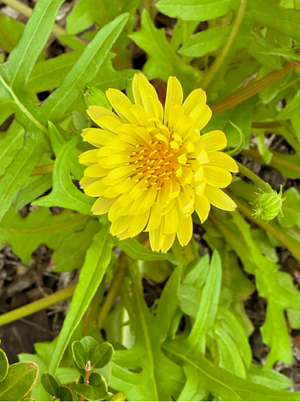Posted on Mar 31, 2023 in
THE SWEET LIFE GARDENER
Hey Sweet Lifers! Recently, I saw a post from a dear friend regarding a perished bee having fallen prey to the hand of an unscrupulous person who thought it swell to put pesticides on their dandelions. Dandelions are not weeds! In the spring, they are some of the first flowers to feed the waking up insects in your garden, and dandelions happen to be one of their favorite foods! I tell you this because too many people are unfamiliar with the dandelion, and it is my duty as a steward to inform.
The dandelion was said to have come over to our side of the pond on the Mayflower. Its original origin being Asia and Europe, it has been used for centuries by doctors to treat many ailments. The earliest known records date back to the 10th and 11th centuries. The dandelion, however, is said to have been used by the Romans and Anglo Saxons.
Medicinally, dandelion has been used for treating ringworm, eczema, lowering blood pressure, cleaning the liver and urinary tract, as a mild laxative and to stimulate insulin production. The roots are harvested to make tinctures or decoctions while the leaves can be dried to make a diuretic tea, but be careful not to drink it before bedtime as it has a reputation with the French of making you pee your bed!
In the garden, dandelions are of great benefit to other plants because of their deep roots, which extract nutrients for companion plants providing them with easier access to nutrition. They also give off nitrogen and minerals into the soil making for a healthier soil in general. As mentioned earlier, they are a favorite food source for pollinators who enjoy their nectar from their tube-like florets packed densely into their flower head.
In the kitchen, dandelions are a great source of vitamin C, vitamin K1, potassium, magnesium and beta-carotene. The leaves are very tasty in spring salads, sautéed with olive oil and garlic and a sprinkle of lemon, added to pesto, baked in eggs and ham and countless soups and savory pastries. The roots can be dried and ground to make a coffee and the flowers steeped to make dandelion wine or a sweet marmalade spread for morning toast.
Here’s a recipe for making the famous the Dandelion Wine in Ray Bradbury’s book, which was very popular in the 1950s.
Dandelion flowers
 Ingredients:
Ingredients:
Two quarts of Dandelion flowers
Four quarts of water
Two oranges and two lemons
2 1/4 teaspoons of active dry yeast
3 1/2 pounds of sugar
Rinse the flowers and set to boil in water for 25 minutes. Cut the fruit and add to the pot. Let completely cool. Add the yeast. Leave on counter for two days. Strain through cheesecloth and place the liquid in a large bowl. Stir in the sugar. Funnel into a large jar with an air tight top. Let stand for six weeks. Strain and move to bottles letting them age for six months
Recipe yields approximately five bottles.
I do hope this has changed your mind about the dandelion. She’s a spring starting beauty and worthy to remain unattended to in all of our gardens, providing both humans and beloved insects some really amazing benefits!
Keeping on growing!
Alisa


 <
<






 Ingredients:
Ingredients: